University breaks ground on innovation center
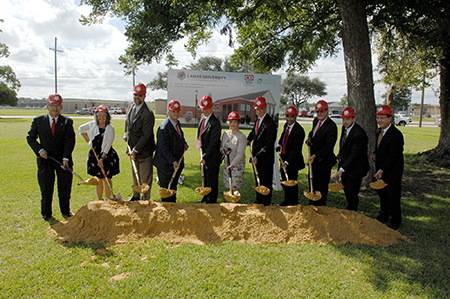 Lamar University announced today it has broken ground on a new 21,000 square-foot innovation center on campus next to its new administration building.
Lamar University announced today it has broken ground on a new 21,000 square-foot innovation center on campus next to its new administration building.
The new Center for Innovation, Commercialization, and Entrepreneurship (CICE) will house offices, labs, meeting space, training areas and an event center. The building on the corner of Rolfe Christopher Drive and Jim Gilligan Way on the south end of the LU campus will open in 2017.
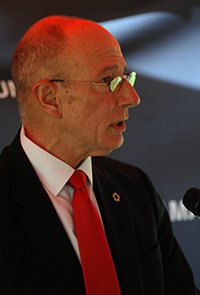 The CICE is a partnership between Lamar University’s College of Business and College of Engineering and the Southeast Texas business community. The center is a conduit for industry and university interaction, including projects, on-going research, student experiential learning, special events and training. The center promotes a strong emphasis on student development and training to prepare graduates for rewarding careers by familiarizing them with entrepreneurial real-world projects. New businesses supported by the center are technology-focused providing products and services for existing and future industry.
The CICE is a partnership between Lamar University’s College of Business and College of Engineering and the Southeast Texas business community. The center is a conduit for industry and university interaction, including projects, on-going research, student experiential learning, special events and training. The center promotes a strong emphasis on student development and training to prepare graduates for rewarding careers by familiarizing them with entrepreneurial real-world projects. New businesses supported by the center are technology-focused providing products and services for existing and future industry.
“This is an exciting day in the life of Lamar University,” said Lamar University President Kenneth Evans. “We are proud to be partners in this historic event and look forward to the promising future this new building offers our campus and community.”
The ground-breaking program, attended by a crowd of business community, regional and university leaders, heard from LU President Kenneth Evans, College of Business Dean Henry Venta, College of Engineering Dean Srinivas Palanki, Greater Beaumont Chamber of Commerce President Regina Lindsey, and CICE Director Paul Latiolais.
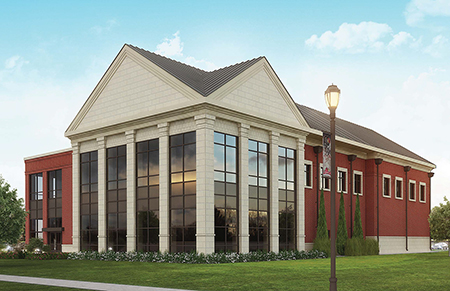
The building will provide structure for innovation-based companies through mentoring and access to university expertise. The CICE will assist companies evaluating opportunities in the region, helping provide “soft landing” and new company development to help diversify the economy, Latiolais said. The CICE will enhance the university’s industrial relations and provide space for student engagement and workforce development, he said.
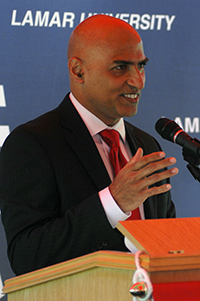 “Lamar’s CICE helps bring innovative ideas to market through creative product development, fast-paced technology and business assessment and validation, and collaboration across all disciplines,” Latiolais said. The CICE is a key player in the university’s continuing collaboration with regional leaders, industry and the professional community for economic development throughout Southeast Texas, he said.
“Lamar’s CICE helps bring innovative ideas to market through creative product development, fast-paced technology and business assessment and validation, and collaboration across all disciplines,” Latiolais said. The CICE is a key player in the university’s continuing collaboration with regional leaders, industry and the professional community for economic development throughout Southeast Texas, he said.
“The new center will provide our faculty and students as well as the business community an environment of innovation and connectivity among entrepreneurs and researchers elevating our collective impact on the economic climate of Southeast Texas while also providing an amazing research and educational opportunity,” Evans said.
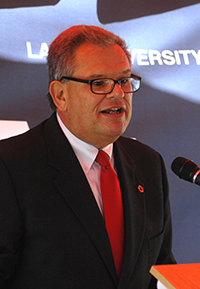 “Today is a crucial point in a long journey that began in 2000, and was enriched by the 2004 TIPS report emphasizing the need for a diversified economy and highlighting the importance of Lamar University as a catalyst for economic development in the region,” said Venta, who also serves as chair of the CICE steering committee. He thanked many individuals and organizations that had played roles in making the day possible, including the South East Texas Regional Planning Commission, the Regional Economic Development Initiative Committee, area Economic Development Commissions, Jefferson County Commissioner’s Court, City of Beaumont, and the Greater Beaumont Chamber of Commerce and its Advancing New Technologies committee.
“Today is a crucial point in a long journey that began in 2000, and was enriched by the 2004 TIPS report emphasizing the need for a diversified economy and highlighting the importance of Lamar University as a catalyst for economic development in the region,” said Venta, who also serves as chair of the CICE steering committee. He thanked many individuals and organizations that had played roles in making the day possible, including the South East Texas Regional Planning Commission, the Regional Economic Development Initiative Committee, area Economic Development Commissions, Jefferson County Commissioner’s Court, City of Beaumont, and the Greater Beaumont Chamber of Commerce and its Advancing New Technologies committee.
“The CICE will be an important complement to our engineering education,” Palanki said. “Our college motto is ‘Imagine it. Design it. Build it. Improve it.’ To that, we are going to add ‘Commercialize it.’”
“As an economic development professional, I can tell you there is no stronger pull than collaboration,” Lindsey said of the chamber’s close relationship with the university. “Lamar University is already very well known for the excellence of its programs. The CICE will add an important element to the efforts to diversify this economy.”
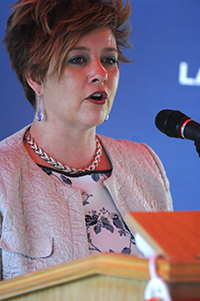 Long Architects, Inc., of Beaumont, designed the building. Construction is funded by a Community Development Block Grant through the U.S. Department of Housing and Urban Development and the Texas General Land Office. The building’s design complements that of one of the university’s other major construction projects, the Wayne A. Reaud Administration Building, being built across the street from the site of the CICE. Together the buildings will create a new entrance to the campus.
Long Architects, Inc., of Beaumont, designed the building. Construction is funded by a Community Development Block Grant through the U.S. Department of Housing and Urban Development and the Texas General Land Office. The building’s design complements that of one of the university’s other major construction projects, the Wayne A. Reaud Administration Building, being built across the street from the site of the CICE. Together the buildings will create a new entrance to the campus.
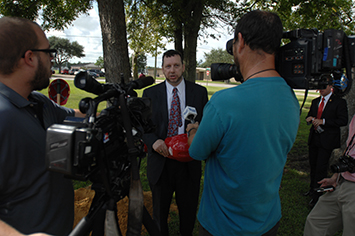 Home to more than 15,000 students, Lamar University is among the fastest growing Texas colleges and universities, and is a member of The Texas State University System. The university has been nationally recognized for the quality of its core curriculum and the diversity of its student body. LU stresses academic achievement by emphasizing hands-on learning at all levels, providing ample opportunities for undergraduate research and supporting an excellent Honors Program. The university is accredited by the Commission on Colleges of the Southern Association of Colleges and Schools.
Home to more than 15,000 students, Lamar University is among the fastest growing Texas colleges and universities, and is a member of The Texas State University System. The university has been nationally recognized for the quality of its core curriculum and the diversity of its student body. LU stresses academic achievement by emphasizing hands-on learning at all levels, providing ample opportunities for undergraduate research and supporting an excellent Honors Program. The university is accredited by the Commission on Colleges of the Southern Association of Colleges and Schools.
“Although we have come a long way, this is not the end of the journey, or even the beginning of the end,” Venta said. “Instead, it is the start of an even more important endeavor for the future of Lamar University and Southeast Texas.”


